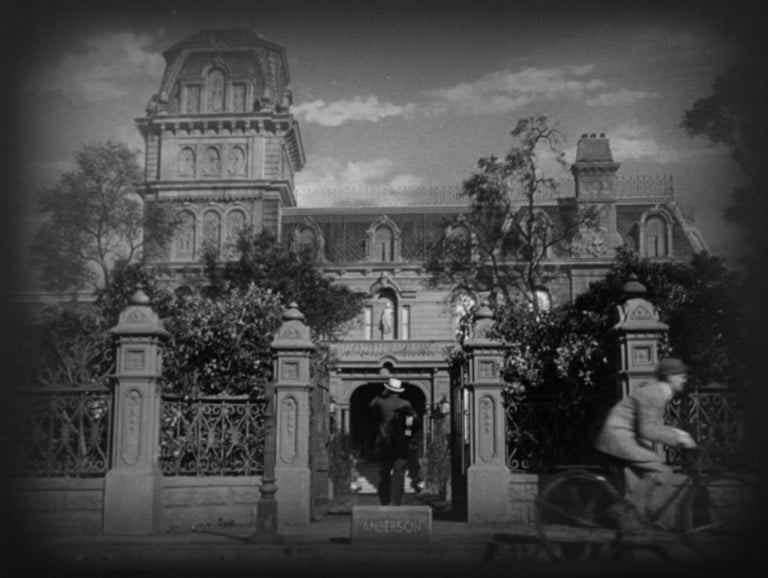The writer L.P. Hartley once opined that “the past is a foreign country; they do things differently there.” Since “The Magnificent Ambersons” was released in 1942, critics have lamented that crucial parts of Orson Welles’ second movie never made it past customs into the present. After a test screening of the film went badly, studio executives cut the film down from two-and-a-half hours to 88 minutes, irreparably damaging Welles’ original vision.
Even in this compromised version, however, Welles is able to transport viewers to a lost land of days gone by. He intones in his rich baritone voice that “the magnificence of the Ambersons began in 1873. Their splendor lasted through all the years that saw their midland town spread and darken into a city.” Then, in both his images and his narration, he surveys the strange customs of America’s Gilded Age. For Welles, the past is a procession of horse-drawn carriages, a profusion of coats and top hats that go in and out of style, and a plethora of elegant society balls. Yet, after this splendid opening sequence, Welles turns his attention to the real subject of the film — how the foreign past transforms into the familiar present. Ultimately, despite their magnificence, the Ambersons fade away because they are never able to adapt to modernity.
“The Magnificent Ambersons” was based on a novel by Booth Tarkington. While Tarkington received the Pulitzer Prize in 1912 for his work, the story he told was not especially unique. America had been filled with families like the Ambersons in the period after the Civil War. The Rockefellers, Vanderbilts and Astors became enormously wealthy. By the time Tarkington wrote the book, most of these families were in decline. The Supreme Court forced them to break up their monopolies on oil, steel and other commodities, and the government began to keep a closer watch on their unscrupulous business dealings.
Like the Astors in Manhattan, the Ambersons in the Midwest built up their fortune by dealing in real estate. Still, the courts and the government do not doom the family. Their own personal failings contribute to their downfall. Isabel, the matriarch of the clan, has never really loved her husband. She has always been enamored with the entrepreneur Eugene Morgan. Her spoiled son, George, decides that he would rather become a professional playboy than worry about real estate. He chases after Eugene’s daughter, Lucy. The relationship between the Morgans and the Ambersons becomes strained, however, because of the actions of George’s crazed Aunt Fanny. Fanny was also in love with Eugene once, and she keeps resurrecting old feuds.
Amidst all this interpersonal turmoil, it is not surprising that the Ambersons neglect their business. Indeed, they do not behave as an elite family should. After making a sizable fortune in the steel business, mogul Andrew Carnegie wrote “The Gospel of Wealth.” In this essay, Carnegie proposed that the most prosperous members of society should become philanthropists and assist the poor. Towards the end of his life, Carnegie gave away most of his fortune to establish libraries, museums, concert halls and universities throughout America. The Ambersons, however, do not abide by any of Carnegie’s advice. While Carnegie cautioned that “it is not well for the children that they should be so burdened” with money, George has full access to the family fortune. He becomes a spoiled brat. Carnegie warned that wealthy families must look forward and not anticipate “a relapse to old conditions.” Still, neither Isabel nor Fanny can move past the past. Most damningly, Carnegie claimed that “there is no class so pitiably wretched as that which possesses money and nothing else.” The Ambersons are so obsessed by their own problems that they possess few virtues. Sequestered in their sprawling mansion, they are totally insulated from the community.
Because of their isolation, they do not realize their splendor is fading until it is too late. Eugene’s last invention is a motorcar, and the advent of the automobile has adverse effects on the Ambersons. If everyone has a car, they no longer need to own real estate downtown, and the prestige of the Ambersons will plummet. Welles foreshadows this coming cataclysm in one startling shot. Eager to prove that his invention can withstand winter weather, Eugene invites all the Ambersons to join him on a joyride. Welles shows the car gliding through the pure, white landscape, and his shot resembles a Currier and Ives print. In their colorful and cheerful pictures of the snowy countryside, Currier and Ives would depict some townsfolk seated on a sleigh. Welles and Currier and Ives create similar images, but Welles has replaced the plush, carpeted sleigh with a hideous, gas-guzzling machine. Just as the Currier and Ives sleigh has fallen out of the frame, the Ambersons will soon lose their place in society.
All of the characters spend much of the movie denying this fundamental truth. “Automobiles are a useless nuisance,” George protests. Even Eugene admits that “they may be a step backward in civilization,” but ultimately, he concludes “automobiles have come.” No amount of money can change that. As the Ambersons face their inevitable downfall, Welles starts to linger over the shadows in the mansion. By end of the film, even the magnificence of the Ambersons has become a slight shadow.
Since only a shadow of Welles’ initial version exists, some critics might say that we cannot fully appreciate his artistry. They would curse the executives who cut the film. Still, perhaps Welles was partly to blame for the mutilation of his movie. Like the Ambersons, he was removed from the tenor of his times. Americans felt that they were capable of winning World War II, but the Ambersons could not surmount the challenges of modernity. Yet, if the splendor of the Ambersons was lost “as their midland town spread and darkened into a city,” the fragment of “The Magnificent Ambersons” that remains resonates magnificently in the present.
Contact Amir Abou-Jaoude at amir2 ‘at’ stanford.edu.
